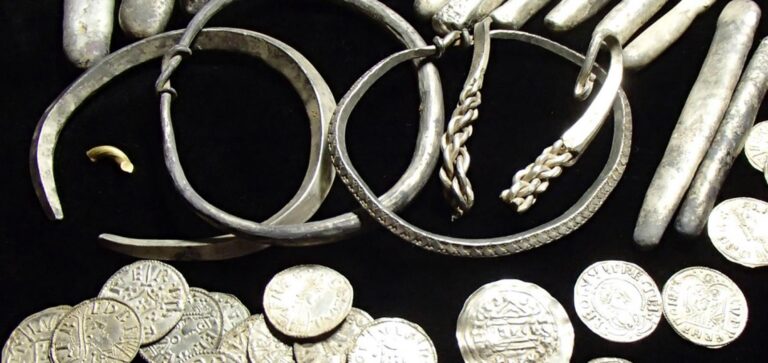Hoards are among the most important archaeological finds for many cultures, including the Vikings.
A hoard could also be called a “wealth deposit”, because they are basically a group of valuable objects collected by someone and then deposited somewhere, usually in the ground.
It is assumed that most hoards were deposited to protect wealth, with the intention of returning for it later.
For example, if your village was being attacked, you might deposit your wealth at a secret location in the ground to prevent it from being taken.
Similarly, if you were going off on a raiding mission, you might bury your valuables to protect them while you are away.
However, the Vikings also believed that burying things in the ground was a way to pass things from the mortal world to the divine.
So, some hoards may also have been buried as offerings to the gods. Or a person could bury a hoard for the purpose of retrieving the items in the afterlife.
According to Odin’s Law given in the Heimskringa saga, men were allowed to bring with them to Valhalla everything that was burned with them on the funeral pyre, and anything they had personally buried in the ground.
Where are Viking Hoards Found ?
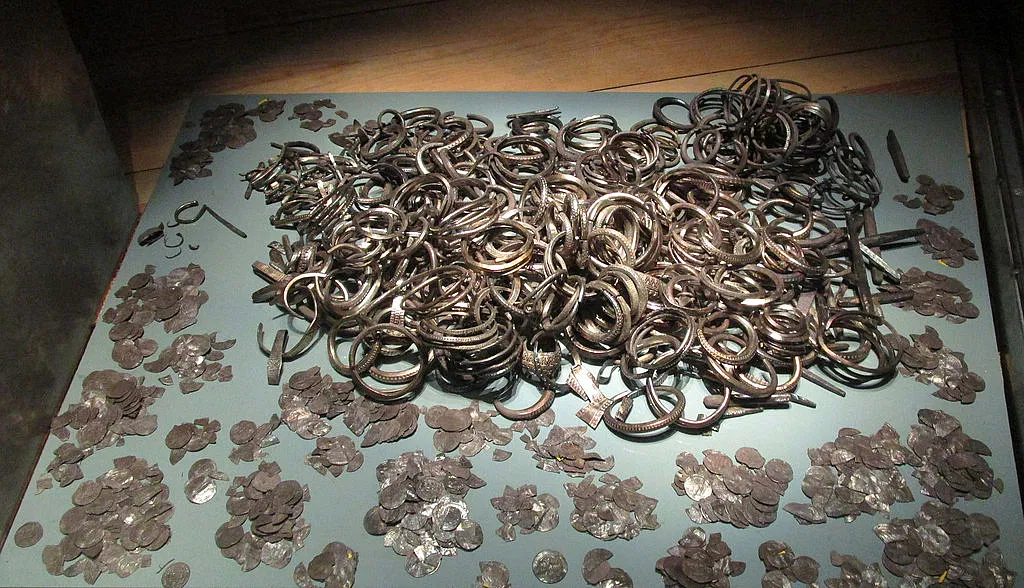
We think of the Vikings as raiders and pillagers who traveled overseas to steal other people’s wealth, but once they acquired wealth, they also thought that it was worth protecting.
But burying hoards seems to have been more common for traders than raiders.
During the Viking Age, Gotland, now considered part of Sweden, was a wealthy Viking domain that did extensive trade with allies in the east as far as Russia and the Byzantine Empire.
More than 700 Viking hoards have been found on that island alone, including more than 180,000 coins, reflecting their status as traders.
By comparison, only 80,000 coins have been found in hoards from the rest of mainland Sweden.
Viking Hoards have also been found throughout the British Isles, but not necessarily in the places they were expected.
A limited number of hoards have been found around the main Viking settlement areas such as Viking York, with the exception of the famous Vale of York Hoard, and none have been found around Dublin, which was another major Viking settlement.
Instead, they are found in the trade zones around the Irish Sea, suggesting that it was traders, like the people of Gotland, who were in the habit of burying hoards.
Other hoards have been found across the Viking world, in Denmark, Sweden, Norway, Iceland, the Orkneys, and the Baltics, but nowhere has the same concentration of hoards as Gotland.
Burying a Viking Hoard ?
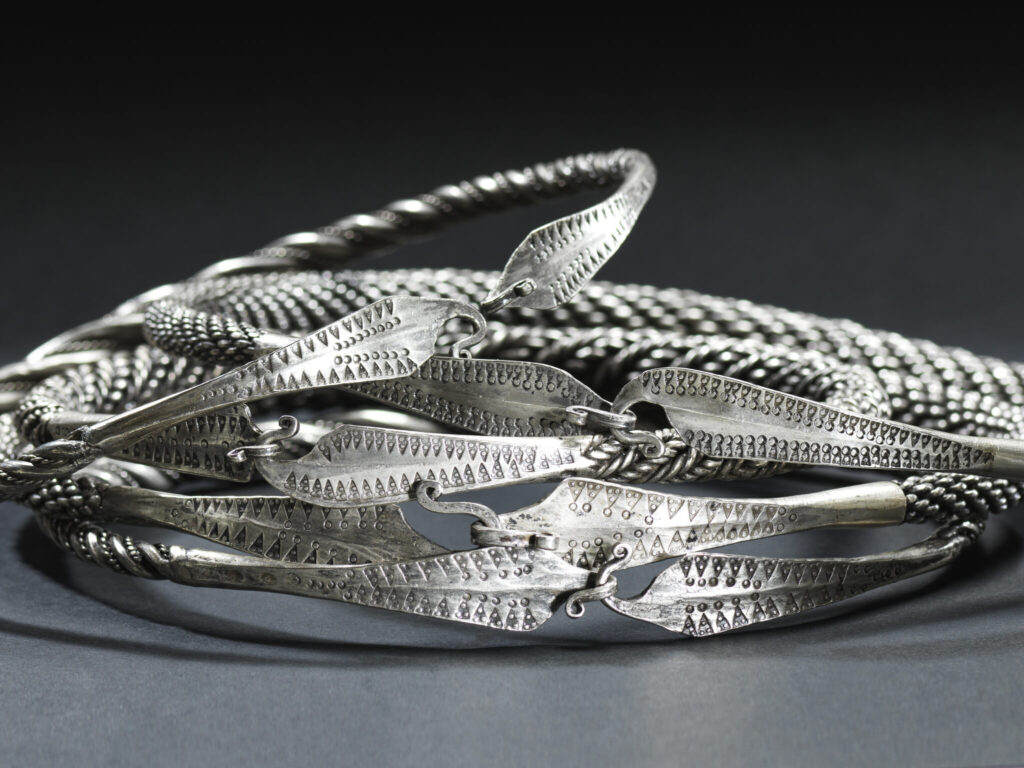
What type of scenario could lead to the burial of a Viking hoard ?
A recent archaeological excavation at a farm in Ardal in Hjelmeland, Norway throws some light on that question.
The excavation was initiated there in 2024 when the landowner called in archaeologists to survey the route of a tractor road that he was planning to build.
They found evidence of an extensive Viking farm, including dwellings for people, outbuilding for animals, and many artifacts, including fragments of soapstone pots, rivets, knife blades, and whetstones.
They also found a hoard of four silver arm rings, buried close together just eight inches under the surface of the earth.
The deposit does not seem to have been disturbed since it was placed there in the 9th century.
This is unusual, as hoard objects are often distributed and removed from their original archaeological context by plowing.
The arm rings were found under what was once the floorboards of a small house.
Because of the size of the house and the fact that no other artifacts were found in the vicinity suggests to archaeologists that these may have been the slave quarters.
The excavation also found that the farm was burned down around the time that the silver arm rings were deposited into the ground.
This suggests a specific scenario. The occupants of the farm were aware that they were facing attack and buried their valuable arm rings under the slave quarters, assuming that this was the last place that raiders would look.
However, it seems that they probably lost their lives, or at least their liberty, as they never returned for the pieces.
What Objects are Found in Viking Hoards?
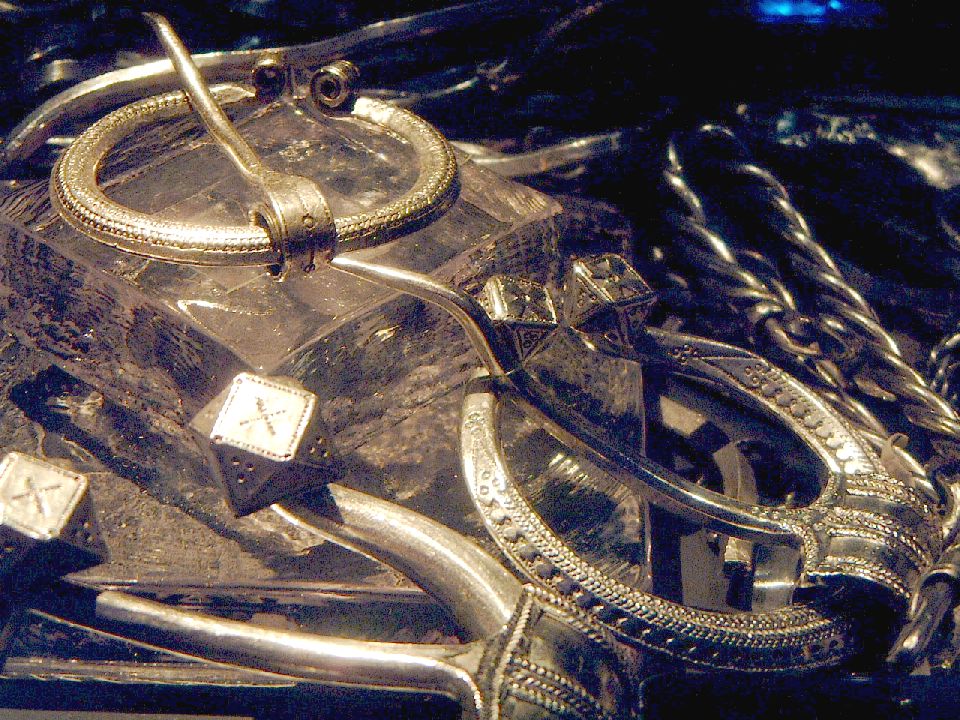
Aside from coins and arm rings, what other types of objects can you expect to find in Viking hoards ?
The vast majority of Viking hoards were made up of hack silver, which means pieces of silver hacked off a variety of objects.
This type of silver is known as hacksilver and was used as currency.
For example, the Sigsarve hoard from Gotland contains 6 kilograms of silver.
It includes silver ingots, that were made to weight specifically for trade, and then lots of hack silver including parts of pins and brooches, pieces of toques and arm rings, needles, finger rings, silver ear spoons, pieces of silver bowls and plates, and more.
This suggests that the hoard was deposited by a trader, since they would have accumulated hack silver.
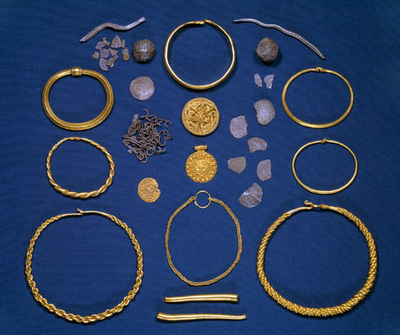
Gold objects were sometimes found in silver boards, but more often they were buried separately or as part of smaller gold hoards.
Since gold was rare and more valuable, it appears less often.
Small gold hoards also seem to have been buried by wealthy individuals rather than traders.
For example, a small gold and silver hoard from Vester Vedsted in Denmark contains gold neck and arm rings, a brooch, pendants, a chain, silver beads, and just a few fragments of hack silver.
The jewelry pieces were intact, rather than cut up, suggesting that these were someone’s prized possessions.
Important Viking Hoards
What can we learn from Viking hoards ?
Lots of things, including what was considered valuable in the Viking Age, and what jewelry styles were contemporary with one another.
The fact that most hoards also include coins also makes them excellent for dating, since coins often provide a terminus post quem for when items could have been deposited. But let’s take a look at a few specific Viking hoards.
Norremolle Hoard
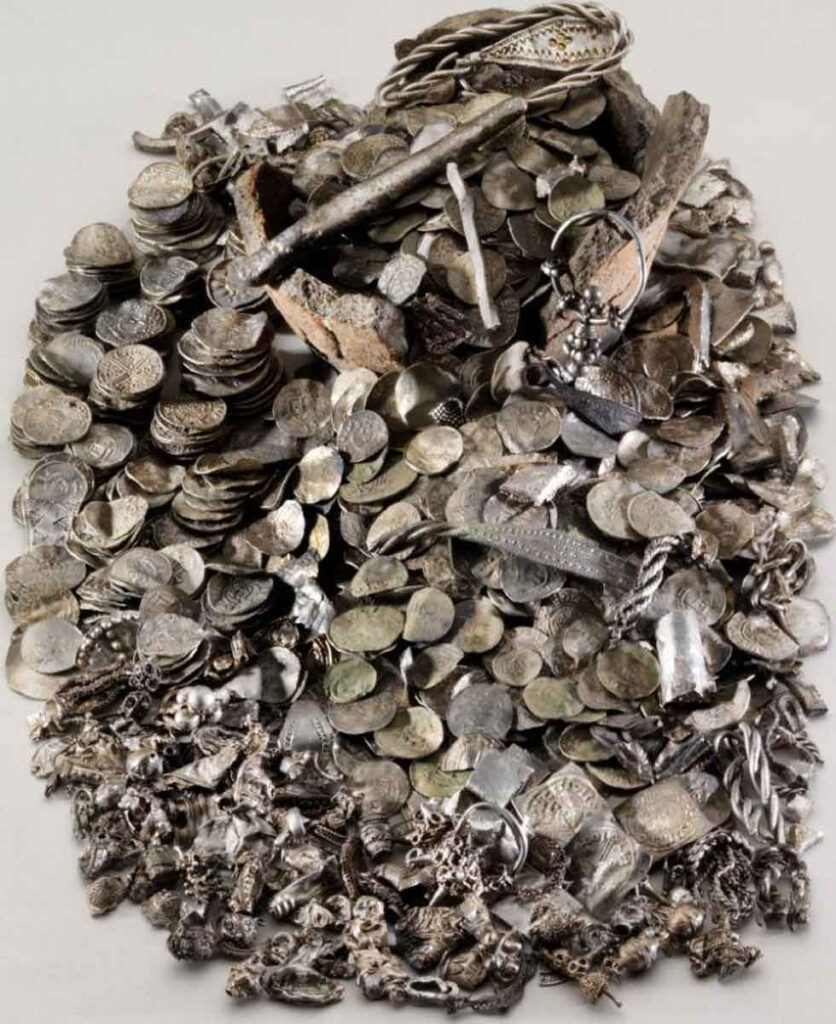
The Norremolle Hoard, discovered on the island of Bornholm in Denmark, is the largest Viking hoard ever discovered containing 1,194 coins plus an extensive array of jewelry and hacksilver.
It contained coins from across the Viking sphere of influence including England, Germany, the Near East, Scandinavia and Bohemia.
It was all kept together in a tan ceramic vessel with no decoration except for a stamp indicating that it was from the Baltic.
Archaeologists discovered that the pot was buried within a structure that had been burned down, thanks to post holes filled with charcoal.
This suggests a scenario similar to Ardal, where the household knew they were under attack, buried their precious items, and were never able to return for them.
The Vale of York Hoard
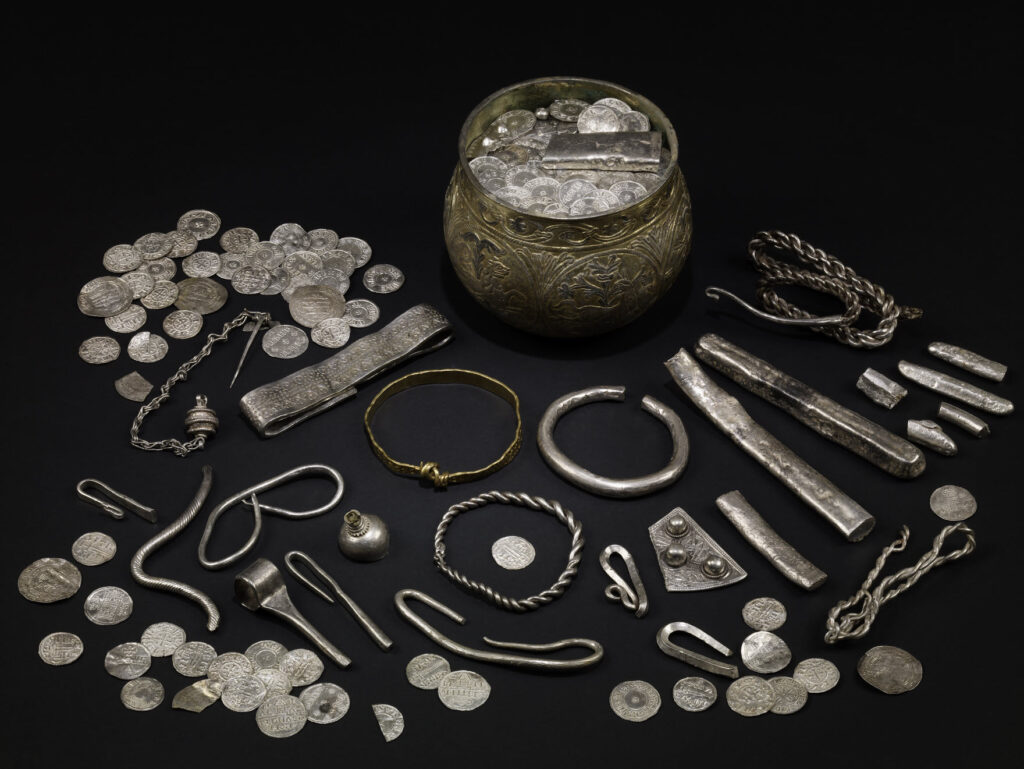
Another hoard was found in the valley of the River Nidd in English Northumbria, not far from Viking York.
It contained jewelry, ingots, hack silver, a silver gilt Frankish vessel, a gold arm ring, five silver arm rings, and 617 coins.
Most of the coins were Anglo-Saxon, suggesting that they represent money paid to the Vikings under Danelaw to stop the Vikings from attacking.
The evidence suggests that the hoard was buried in the mid-920s, which was around the time that King Athelstan took York from the Vikings and united the English.
It could be that this hoard was buried by Vikings fleeing York, who assumed they would return with Viking plans to retake the city.
Hoen Hoard
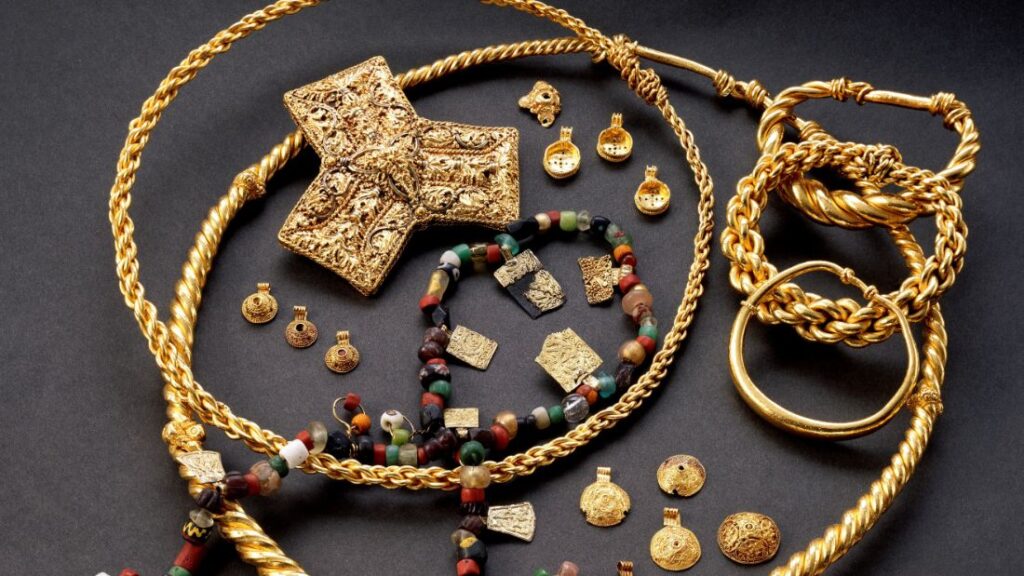
Hoen Hoard is a spectacular Norwegian gold hoard found in a bog.
This suggests that rather than being hidden wealth, it was an offering to the gods, since the Vikings often deposited divine offerings in bogs.
The hoard includes 54 gold and silver objects including a gold neck ring, gold arm ring, three gold finger rings, several gold pendants, and fine glass beads.
Treasures from Viking Hoards
While Viking hoards represent important archaeological finds that can deepen our understanding of the Viking world, here at VKNG we get excited about new Viking hoard finds for a different reason.
The pieces in our collection are inspired by genuine jewelry worn by the Vikings.
Each new hoard find brings new design inspirations that help us authentically expand our collection.
